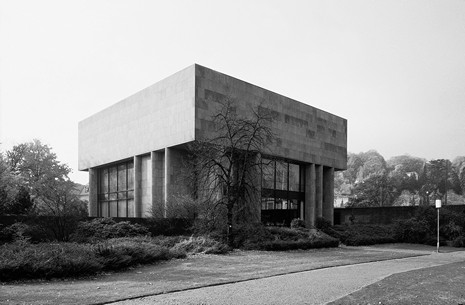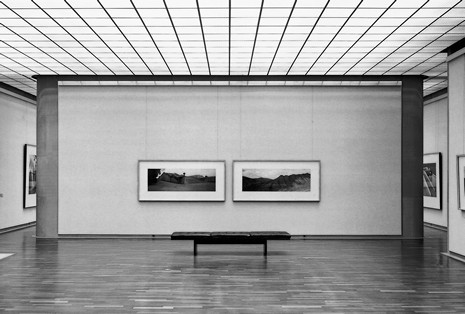Description
At the instigation of Rudolf August Oetker, an industrialist and patron of the arts from Bielefeld, this commission was awarded to Philip Johnson, who had already built six museums in the United States.
Located on a large traffic axis, the building – which appears massive at first glance – opens with two expansive glazed fronts toward a park. It consists of five floors on a square ground plan of 30 x 30 metres (originally it was supposed to be 40 x 40 metres), of which only the three uppermost ones with the exhibition rooms are visible above the level of the street. Two underground floors contain offices, a conference hall, a library, depots, and workshops. The structure of the cube develops out of the tension between the heavy, closed volume of the top floor and the asymmetrically organized verticals of the rounded-off walls that protrude from the recessed parts of the remaining volume, which are partially glazed, up to the alignment of the top storey. It thus suggests an interpenetration between interior and exterior. In addition to the solidity of the materials used – a reddish sandstone for the cladding of the reinforced concrete – the most simple proportions based on whole-number units (which probably were inspired by the studies of Johnson’s friend, the art historian Rudolf Wittkower, on the aesthetic proportions of Renaissance architecture) emphasize the significance of this building task.
On the top floor the interior is lit from above through a gridwork ceiling, while the remaining floors are illuminated by a combination of lateral and artificial light. By means of walls of varying lengths arranged perpendicularly to each other, visible from the outside, it is divided the same way on all the floors into rooms of different sizes that flow into each other. From the spacious entrance hall, a stairway placed in the centre of the building leads to the exhibition levels, which are also accessible via a second stairway next to the entrance.
In spite of the evident sophistication of the architecture, the spatial organisation oriented toward the centre, varied but never confusing, enables an entirely appropriate presentation of the twentieth-century artworks.
J.W. von Moltke, “Das Richard Kaselowsky-Haus, Kunsthalle der Stadt Bielefeld”, in: Museumskunde 32/1967, pp. 76-85 • Bauwelt 42/1968, pp. 1300-1301 • Deutsche Bauzeitschrift 1/1969, pp. 37-40 • Georg Syamken, “Die Kunsthalle der Stadt Bielefeld”, in: Museum und Kunst. Beiträge für Adolf Hentzen, Hamburg, 1970, pp. 266-276 • Henry-Russel Hitchcock, Die Bielefelder Kunsthalle, Bielefeld, 1974 • Peter Blake, Philip Johnson, Basel, 1996, pp. 114-115
Drawings
Site plan
Ground floor
Second floor
Third floor
Section
Photos

View from the park (from the east)

View of the exhibition area on the second floor
Originally published in: Paul von Naredi-Rainer, Museum Buildings: A Design Manual, Birkhäuser, 2004.